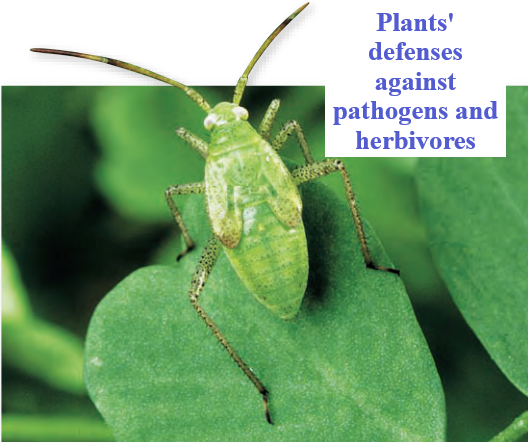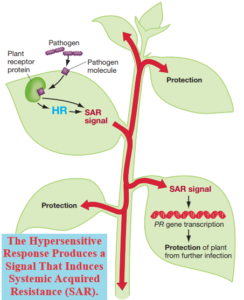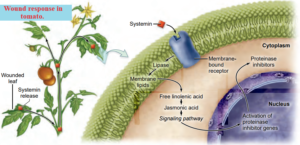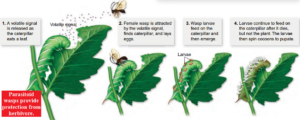How Plants Defend Themselves Against Pathogens and Herbivores.

Introduction
Plants cannot run away from danger. Instead, they have to stand and fight.
Like humans and other animals, plants are constantly threatened by an array of disease-causing viruses, bacteria, and parasitic fungi.
In addition, plant roots are susceptible to attacks by nematodes and soil-dwelling roundworms.
Disease-causing agents are termed pathogens.
If plants were not able to sense attacks by pathogens and respond to them quickly and effectively, the landscape would be littered with dead and dying vegetation.
The waxy cuticle that covers epidermal cells is an effective barrier to most viruses, bacteria, fungi, and other disease-causing agents, and the structures called thorns, spines, and trichomes help protect leaves and stems from damage by herbivores.
These represent examples of physical defense.
In addition, many plants lace their tissues with secondary metabolite molecules that are closely related to compounds in key synthetic pathways but are not found in all plants.
Some secondary metabolites function in plant defense by poisoning herbivores.
These represent examples of chemical defense.
- The flavourful oils in peppermint, lemon, basil, and sage have insect-repellent properties.
- The pitch that oozes from pines and firs contains a molecule called pinene, which is toxic to bark beetles.
- The pyrethroids produced by Chrysanthemum plants are a common ingredient in commercial insecticides.
- Molecules called tannins are found in a wide array of plant species; when they are ingested by animals, tannins bind to digestive enzymes and make the herbivores sick.
- Compounds like opium, caffeine, cocaine, nicotine, and tetra- tetrahydrocannabinol (THC) disrupt the nervous systems of plant-eating insects and vertebrates.
Although these defenses are effective, they are also expensive for plants to produce in terms of the ATP and materials invested.
It is not surprising that plants often produce defenses or increase their existing defenses only in direct response to attacks by pathogens or herbivores.
Responses to attacks and infections in both plants and animals are called inducible defenses because they are triggered by the presence of a threat.
Let’s first consider how plants sense and respond to viruses and other pathogens and then explore what they do when attacked by insects and other herbivores.
How Do Plants Sense and Respond to Pathogens?
Like animals, plants have remarkably swift and diverse defense mechanisms to resist attacks by viruses, bacteria, and fungi.
Plants use a wide variety of sensory proteins to detect invading pathogens and use signalling pathways to carry out their defense.
Successful pathogens, in turn, have evolved elaborate mechanisms to evade these defenses.
An Evolutionary Arms Race
Most plant pathogens are very specific, infecting only one or a few host species.
This is in part due to the long history of coevolution of the pathogen and its host.
If a pathogen evolves a mechanism to exploit its host more effectively, the host may evolve new abilities to detect the pathogen and defend itself from attack.
In response, the pathogen may then evolve an alternate strategy to evade detection by the host.
The complex interactions that have resulted from this back-and-forth “arms race” have proved challenging for biologists to understand.
The human food supply is estimated to be reduced by 50 percent worldwide because of plant disease.
In the mid-1800s, Ireland experienced a potato famine in which millions of people faced starvation because of a potato pathogen.
Pathogens can also be devastating to native species.
The once-dominant American chestnut tree was nearly wiped out by a fungal pathogen in the early 1900s.
To cause disease, plant pathogens must first get past the surface of a host plant and begin growing in the apoplast, outside the plasma membranes of cells.
Most pathogens enter through stomata or wounds. Once inside the plant, some pathogens kill host cells and feed on the cell debris.
More commonly, a pathogen feeds on nutrients from a host cell while it is still alive.
How do the plant cells respond to an attack in progress?
The Hypersensitive Response
Plant cells contain a variety of receptor proteins that can bind to molecules derived from pathogen cells. When contact is made, these “surveillance” proteins signal to the plant cell that a pathogen is present, which triggers a cascade of signals that lead to
- stomatal closure, preventing more pathogen cells from entering the plant;
- production of toxin molecules targeted to the pathogen;
- reinforcement of the neighboring plant cell walls to limit movement of the pathogen; and
- rapid suicide of cells in the infected region.
These events take place within hours of the start of an infection and are termed the hypersensitive response (HR).
The HR results in small brown spots in leave those cells dead by suicide that accumulate over the growing season.
By the end of the growing season, it is rare to find leaves lacking these brown spots.
Plants that can detect an infection quickly and induce an HR to remain healthy and show no further signs of disease.
The HR is similar to the cell-mediated immune response in mammals, which leads to the death of infected cells.
An Alarm Hormone Extends the HR
Once the HR is under way in a localized area of infection, a hormone produced at the infection site travels throughout the body and triggers a slower and more widespread set of events called systemic acquired resistance (SAR).
Over the course of several days, SAR primes cells throughout the root or shoot system for resistance to assault by a pathogen even cells that have not been directly exposed to the disease-causing agent.
In addition to triggering the HR, the detection of a pathogen leads to the release of a hormone that initiates SAR.
This signal acts globally as well as locally that is, at the point of infection, and results in the expression of a large suite of genes called the pathogenesis-related (PR) genes.
When expressed, these genes produce proteins that help prevent an infection from spreading.
When biologists set out to locate the hormone responsible for SAR, they found that levels of methyl salicylate (MeSA) a molecule derived from salicylic acid increase dramatically after tissues are infected with a pathogen.

Follow-up work revealed these findings:
- Phloem sap leaving infected sites has elevated levels of MeSA.
- Treatments that reduce MeSA reduce or abolish SAR.
- Adding MeSA to the lower leaves of tobacco plants leads to SAR in the upper, untreated leaves.
Biologists are working to understand these complex interactions to genetically engineer crop plants that can resist diseases.
Despite these interventions, however, pathogens continue to evolve, in a never-ending arms race.
How Do Plants Sense and Respond to Herbivore Attack?
Wound responses protect plants from herbivores
A wound response may occur when a leaf is chewed or injured.
One induced outcome is the rapid production of proteinase inhibitors.
These chemical toxins do not exist in the stockpile of defenses but instead are produced in response to wounding.
Proteinase inhibitors bind to digestive enzymes in the gut of the herbivore.
The proteinase inhibitors are produced throughout the plant, and not just at the wound site.
How are cells in distant parts of the plant signalled to produce proteinase inhibitors?
In tomato plants, the following sequence of events is responsible for this systemic response
- Wounded leaves produce an 18-amino-acid peptide called systemin from a larger precursor protein.
- Systemin moves through the apoplast (the space between cell walls) of the wounded tissue and into the nearby phloem. This small peptide-signalling molecule then moves throughout the plant in the phloem.
- Cells with a systemin receptor bind the systemin, which leads to the production of jasmonic acid.
- Jasmonic acid activates the transcription of defense genes, including the production of a proteinase inhibitor.

Although we know the most about the signalling pathway involving jasmonic acid, other molecules are involved in wound response as well.
Salicylic acid, which is found in the bark of plants such as the white willow (Salix alba) is one example.
Cell fragments also appear to be important signals for triggering an induced response, as is discussed shortly.
Mechanical damage separate from herbivore attack also elicits wound responses, which presents a challenge in designing plant experiments that involve cutting or otherwise mechanically damaging the tissue.
Experimental controls, which should be cut or manipulated in the same way but without the test treatment, are especially important to ensure that any changes observed are not due only to the wound response.
Physical Defenses:
Pathogens can harm plants in many ways, including exploiting nutrient resources and taking over DNA replication machinery.
-
Dermal tissue provides first-line defense.
Dermal tissues are covered with lipids such as cutin and suberin, which reduce water loss and prevent attack. Morphological features such as trichomes, bark, and thorns protect some plants.
-
Invaders can penetrate dermal defenses.
In spite of defense mechanisms, invaders can cause damage by piercing plants, eating plant parts, or entering the plant through the stomata.
-
Bacteria and fungi can also be beneficial to plants.
Mycorrhizal fungi form beneficial relationships with plants by enhancing uptake of water and minerals. Nitrogen-fixing bacteria provide nitrogen to plants in a usable form.
Chemical Defenses
-
Plants maintain chemical arsenals.
Plants may produce and stockpile secondary metabolites such as alkaloids, tannins, and oils that provide protection from predators.
Plants protect themselves from their own toxins either by sequestering them in vesicles or producing compounds that are not toxic until they are ingested by a predator.
-
Plants can poison other plants.
Allelopathic plants secrete chemicals to block seed germination or inhibit growth of nearby plants.
This strategy minimizes competition for resources such as light and nutrients.
-
Humans are susceptible to plant toxins.
Ricin is an example of a powerful plant toxin.
It is found in the endosperm of castor beans.
Ricin is six times more lethal than cyanide.
-
Secondary metabolites may have medicinal value.
Plant secondary metabolites such as phytoestrogens, taxol, and quinine have pharmaceutical value for humans.
Many other plant- based remedies have been used for centuries in human cultures.
Animals That Protect Plants
Mutualistic associations are beneficial to both the plant and animal partners.
One example is the relationship between acacia trees and ants, in which ants protect the trees from herbivores.
Another example is the association between certain plants, caterpillars, and parasitoid wasps.
When chewed or damaged, the leaves release compounds that attract the wasps, which lay their eggs in the caterpillars.
The wasps’ larvae feed on the caterpillar, killing it








